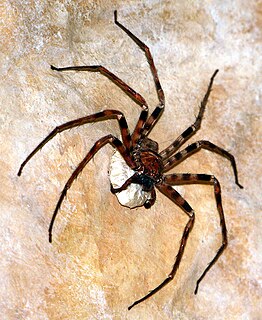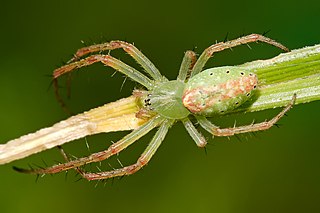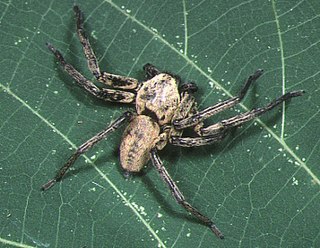
Myrmarachne is a genus of ant-mimicking jumping spiders that was first described by W. S. MacLeay in 1839. They are commonly called antmimicking spiders, but they are not the only spiders that have this attribute. The name is a combination of Ancient Greek μύρμηξ (myrmex), meaning "ant", and ἀράχνη (arachne), meaning "spider".

Cosmophasis is a genus of spiders in the family Salticidae. Some species occur in Africa, while most are found in Southeast Asia, down to Australia. Although most species more or less mimic ants, there are also colorful species that follow a different strategy.

Hyllus is a genus of the spider family Salticidae.

Rhene is a spider genus of the family Salticidae.

Thiania is a genus of jumping spiders that was first described by Carl Ludwig Koch in 1846.

Cyclosa, also called trashline orbweavers, is a genus of orb-weaver spiders first described by Anton Menge in 1866. Widely distributed worldwide, spiders of the genus Cyclosa build relatively small orb webs with a web decoration. The web decoration in Cyclosa spiders is often linear and includes prey remains and other debris, which probably serve to camouflage the spider. The name "Cyclosa" comes from Greek 'to move in a circle', referring to how it spins its web.

Heteropoda is a genus of spiders in the family Sparassidae, the huntsman spiders. They are mainly distributed in tropical Asia and Australia, while at least one species, H. venatoria, has a cosmopolitan distribution, and H. variegata occurs in the Mediterranean.

Cyrtophora, the tent-web spiders, is a genus of orb-weaver spiders first described by Eugène Simon in 1895. Although they are in the "orb weaver" family, they do not build orb webs. Their tent-like, highly complex non-sticky web is sometimes considered a precursor of the simplified orb web. These webs are aligned horizontally, with a network of supporting threads above them. These spiders often live in colonies. Females have a body length of mostly about 10 millimetres (0.39 in) long. Some members, including Cyrtophora cicatrosa, exhibit the ability to change colour rapidly.

Thelcticopis is a genus of huntsman spiders that occurs almost exclusively in the Australasian region, from India to Japan to New Guinea and Fiji. However, one species occurs in Costa Rica, and another in Congo basin, although the latter species is probably misplaced in this genus.

Tetragnatha is a genus of long-jawed orb-weavers found all over the world. It was first described by Pierre André Latreille in 1804, and it contains hundreds of species. Most occur in the tropics and subtropics, and many can run over water. They are commonly called stretch spiders in reference to their elongated body form and their ability to hide on blades of grass or similar elongated substrates by stretching their front legs forward and the others behind them. The name Tetragnatha is derived from Greek, tetra- a numerical prefix referring to four and gnatha meaning "jaw". On the Hawaiian islands, a shift of cursorial behavior occurred long ago, when their ancestors first arrived on the island chain.
Epidius is a genus of crab spiders that was first described by Tamerlan Thorell in 1877. It is a senior synonym of Pothaeus.

Hygropoda is a genus of nursery web spiders that was first described by Tamerlan Thorell in 1894.













